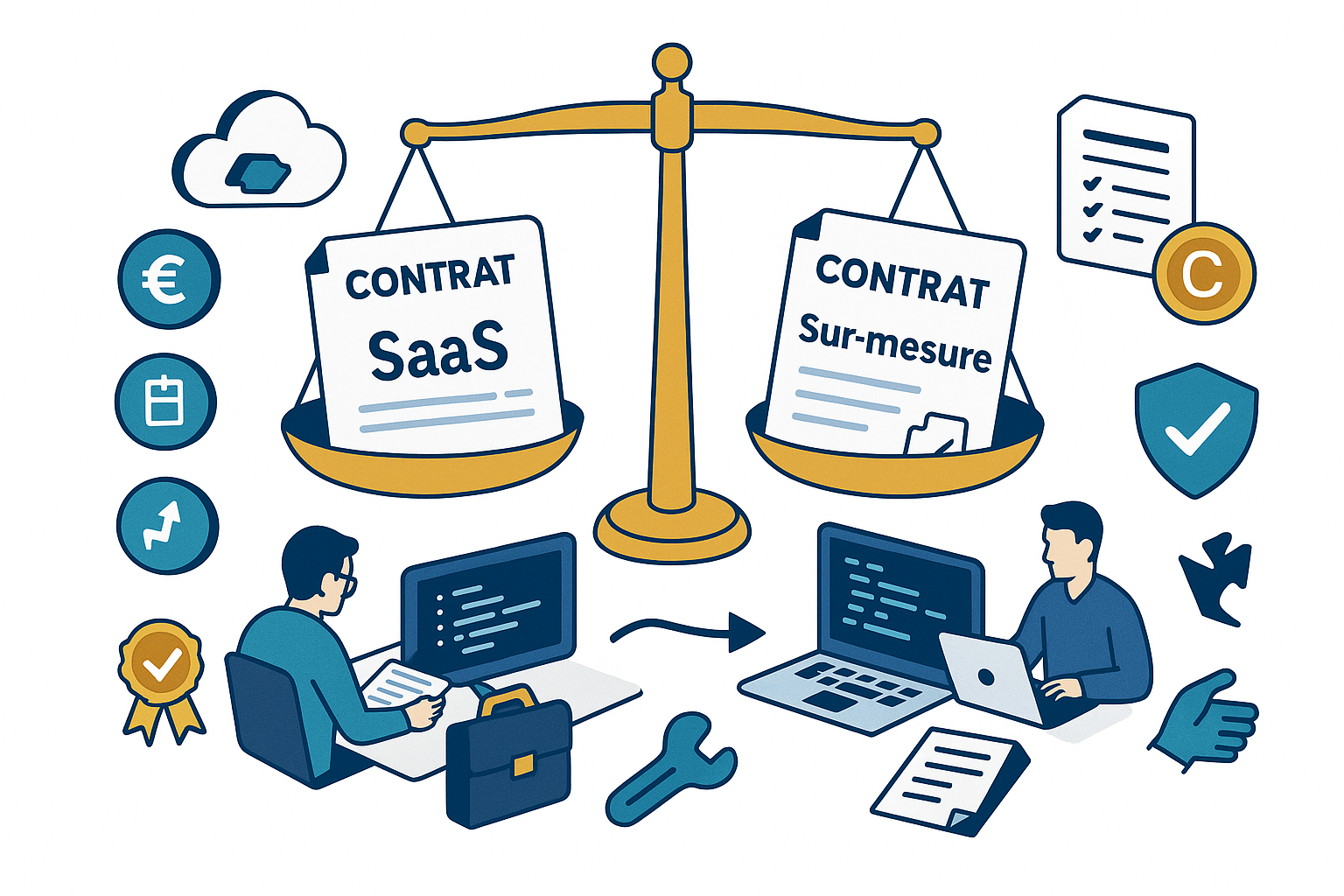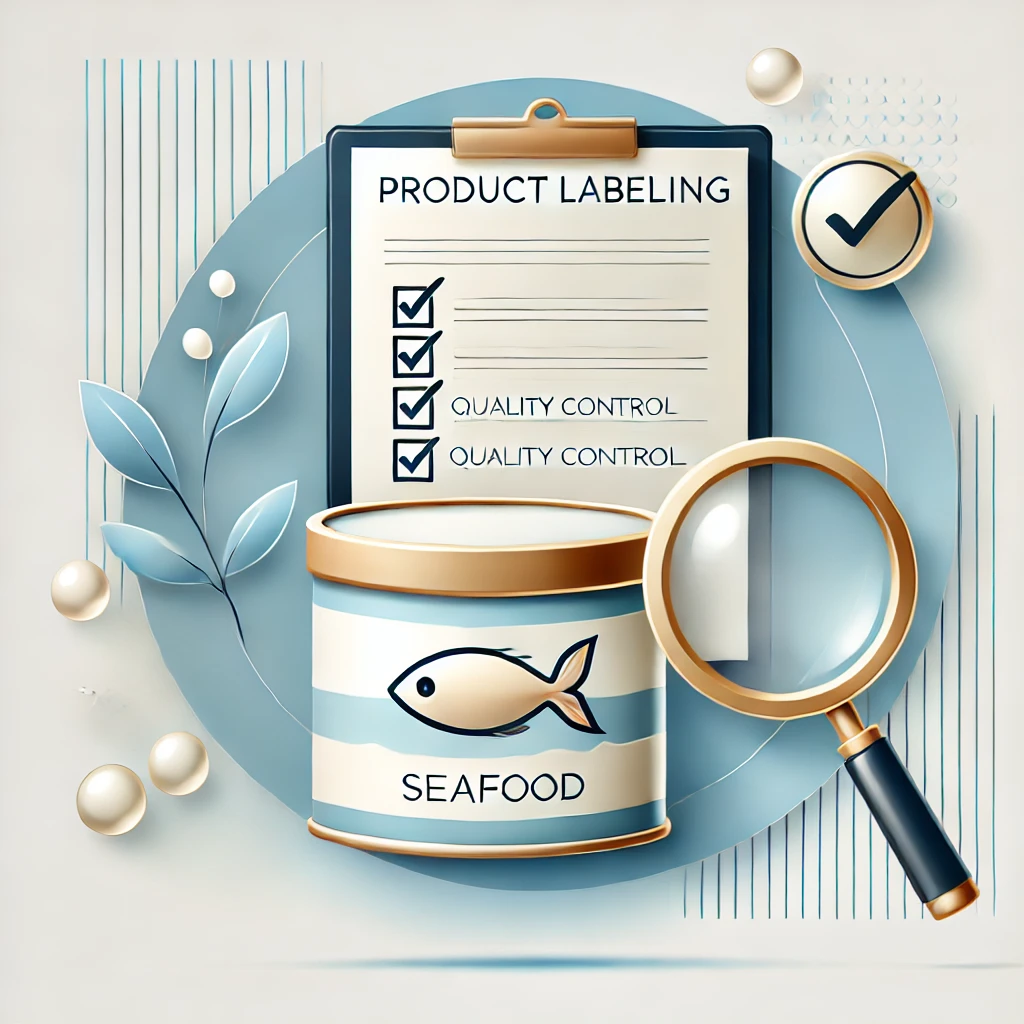Faced with the growing need for digitalization, companies are faced with a fundamental strategic choice: opt for a standardized software solution accessible via a SaaS (Software as a Service) model, or invest in development tailored to their specific needs.
Beyond the immediate technical and financial considerations, these two approaches imply radically different contractual models, with long-term legal, economic and operational implications that need to be meticulously assessed.
This article provides an in-depth comparative analysis to help you decide which model is best suited to your business context.
If you need a software development contract lawyer, contact me!
Understand the legal fundamentals of each model
Before examining the respective advantages and disadvantages, it is essential to understand the distinct legal nature of these two types of contract.
The SaaS contract: a subscription-based service model
The SaaS contract is legally akin to a service contract, in which the publisher undertakes to provide access to an application hosted on its servers in return for a periodic subscription fee. This legal qualification has important implications for the rights and obligations of the parties.
A structural legal analysis of this type of contract reveals several fundamental characteristics:
- No transfer of ownership of the software to the customer
- Provision of a standardized service accessible remotely
- Commitment to availability and performance defined by an SLA (Service Level Agreement)
- Recurring billing in the form of a subscription, usually monthly or annual
- Contractual limitation of customization options
These contracts are generally pre-written by the publisher, with little room for negotiation for customers, particularly for the most standardized solutions on the market.
The customized development contract: a work of art created specifically for you
In contrast, a custom software development contract is legally a contract of enterprise, governed mainly by article 1710 of the French Civil Code. In this model, the service provider undertakes to design and produce specific software to meet the particular needs expressed by the customer.
Targeted contractual expertise highlights the distinctive legal features of this model:
- Creation of an original work adapted to the customer's specific needs
- Precise definition of the functional perimeter in the form of specifications
- Potential transfer of intellectual property to the customer
- Obligation to deliver in compliance with specifications
- Billing generally based on scope and development effort
Unlike SaaS contracts, custom software development contracts are generally negotiated in greater detail, with risks and responsibilities allocated on a project-by-project basis.
Short- and long-term financial implications
The financial dimension is often a decisive criterion in the choice between SaaS and custom development, but this analysis must go beyond the simple initial calculation to include a long-term vision.
SaaS model: predictability and financial flexibility
The financial profile of the SaaS model is characterized by recurring and predictable operating costs, with no significant initial investment required.
The projected financial analysis of this approach highlights :
- Low barrier to entry with limited implementation costs
- Predictable expenses for easy budgeting (monthly or annual subscription)
- Costs correlated to usage (often based on the number of users)
- Upgrades and maintenance included in subscription price
- No investment in technical infrastructure
This cost structure is particularly well-suited to companies with financial flexibility or limited investment capacity. On the other hand, the cumulative cost over several years can be significantly higher than custom development, particularly for applications that are widely used within the organization.
Custom development: initial investment versus long-term control
Custom development follows an investment logic, with high initial costs followed by more controlled maintenance costs.
The strategic financial vision of this approach reveals :
- Significant initial investment in design and development
- Potentially high maintenance and upgrade costs
- Amortization of investment over software useful life
- Potential long-term savings for high-use applications
- Direct control of upgrade and maintenance costs
This financial structure is more suited to organizations with investment capacity and seeking long-term cost optimization. The financial break-even point between the two approaches depends on a number of factors, including the expected useful life and intensity of use of the software.
Personalization and control: strategic challenges
The ability to adapt the software to the company's specific needs and the level of control over its evolution are decisive criteria in the choice of contractual model.
SaaS: limited scope for customization
The SaaS model generally offers a limited level of customization, confined to the options provided by the publisher.
A technical and legal analysis of these limitations reveals several levels of constraints:
- Customization often limited to configuration (parameterization without code modification)
- Visual adaptations restricted to predefined options
- Integration possibilities dependent on publisher-supplied APIs
- Functional evolutions dictated by the editor's roadmap
- Difficulties in adapting to specific business processes
These customization constraints must be carefully weighed against the company's differentiating needs. Some SaaS solutions offer advanced extension or customization mechanisms, but these options are generally contractually restricted, and can entail significant additional costs.
Custom development: total control over functional scope
In contrast, custom development offers total customization and complete control over the functionality developed.
Adaptive contract engineering helps structure this functional freedom:
- Development perfectly aligned with specific business processes
- Seamless integration with existing information systems
- Software evolution driven entirely by customer needs
- Precise adaptation to the desired user experience
- Implementation of differentiating functionalities supporting competitive advantage
This total flexibility is the main advantage of customized development, which is particularly relevant for business processes that represent a competitive advantage or are highly specific. However, it also means greater responsibility for defining requirements and validating developments.
Intellectual property and supplier dependence
The implications in terms of intellectual property and dependence on the supplier are fundamental aspects to consider when choosing between SaaS and custom development.
SaaS: licensing and structural dependency
In the SaaS model, the customer has only a limited license to use the software, creating an inherent dependency on the supplier.
An in-depth legal analysis of this situation highlights several risks:
- Complete dependence on the publisher's continuity
- Vulnerability to price or policy changes
- No control over functional changes
- Difficulty of migration in the event of dissatisfaction (lock-in effect)
- Limited access to data in the event of service termination
This dependency, inherent to the SaaS model, needs to be carefully assessed and contractually framed, notably through reversibility and service continuity clauses. The rise of SaaS solutions has led to increasing standardization of these protections, but their real effectiveness depends largely on the details of their implementation.
Custom development: intellectual property and technical autonomy
Custom development offers the possibility of acquiring full intellectual property rights for the software, guaranteeing long-term autonomy.
The legal protection strategy in this context has several dimensions:
- Assignment of intellectual property rights tailored to customer needs
- Ownership of source code, enabling upgrades by any service provider
- Independence from the continuity of the original service provider
- Complete control over technical infrastructure
- Possibility of valuing intangible assets on the company's balance sheet
This autonomy represents a major strategic advantage for critical or high value-added applications. However, it requires particular attention to the transfer of rights and documentation clauses in the development contract, as well as internal or external capacity to maintain the solution over the long term.
Implementation times and scalability
Speed of implementation and scalability are decisive criteria in the choice of model, particularly in a rapidly changing economic environment.
SaaS: rapid deployment and regular upgrades
The SaaS model is characterized by rapid implementation and frequent upgrades managed by the publisher.
The analytical operational expertise of this model reveals :
- Deployment in days or weeks, depending on complexity
- No initial development required, reducing time and risk
- Regular, automatic updates as part of the subscription
- Functional evolutions benefiting all customers
- Technical scalability generally built into the offering
This agility is a decisive advantage for companies seeking rapid implementation, or operating in sectors undergoing rapid change. The downside is the standardized nature of evolutions, which may not correspond to the customer's specific priorities.
Tailor-made development: complete development cycle and controlled upgrades
Custom development implies a complete project cycle, with longer lead times but total control over evolutions.
A structured methodological approach optimizes this process:
- Design and development lead times generally lasting several months
- Risk of missing deadlines due to complexity or changing needs
- More demanding acceptance and validation processes
- Fully customer-controlled upgrades
- Adaptability to organizational or strategic changes in the company
This approach is particularly suited to projects with stable, well-defined requirements, or where precise control of the development schedule is a strategic issue. The adoption of agile methodologies today makes it possible to partially mitigate time constraints, by favoring incremental deliveries of value.
Safety and regulatory compliance
The challenges of IT security and regulatory compliance are major decision-making criteria, particularly in sectors that are heavily regulated or handle sensitive data.
SaaS: pooling security investments
The SaaS model generally offers a high level of technical security thanks to the pooling of investments, but raises specific compliance issues.
A legal-security analysis of this model identifies several features:
- Benefit from the editor's expertise and security investments
- Fast, automatic security updates
- Pooling of certification and audit costs (ISO 27001, SOC 2, etc.)
- Specific issues relating to data hosting (location, outsourcing)
- Compliance challenges for sensitive or regulated data (healthcare, finance)
The actual level of security is highly dependent on the vendor chosen, and must be thoroughly evaluated, in particular through the examination of certifications, independent audits and contractual clauses specific to security and confidentiality.
Custom development: personalized security and integrated compliance
Tailor-made development enables security and compliance to be integrated right from the design stage (security & privacy by design), with total control over the architecture.
The safety methodology integrated into this approach includes :
- Security architecture precisely tailored to your company's specific risks
- Native integration of industry-specific regulatory compliance requirements
- Complete control over infrastructure and data hosting
- Mastery of security audit and test procedures
- Independence from third-party security policies
This approach enables precise adaptation to specific regulatory requirements, particularly relevant in highly regulated sectors such as healthcare, finance or critical industries. It does, however, require significant expertise and dedicated investment to maintain an optimal level of security over the long term.
Preferred use cases for each model
Beyond these general characteristics, certain company contexts or project types lend themselves particularly well to one or other of these models.
Scenarios favorable to the SaaS model
The SaaS model is generally the preferred solution in a number of typical situations:
Targeted contextual analysis identifies these optimal use cases:
- Standardized support functions (CRM, accounting, human resources)
- Fast-growing businesses requiring immediate scalability
- Organizations with limited IT resources
- Temporary or evolving needs
- Rapid internationalization requires global deployment
In these contexts, the advantages in terms of rapid deployment, reduced initial costs and operational flexibility generally outweigh the limitations in terms of customization and control.
Scenarios for customized development
Conversely, custom development is the optimal choice in other specific situations:
The differentiated strategic vision highlights these privileged contexts:
- Business processes as a key competitive advantage
- Mission-critical information systems requiring a high degree of integration
- Highly regulated sectors with specific compliance requirements
- No standard solution to meet basic needs
- Prospects for long-term use justifying initial investment
In these situations, the investment in custom development is justified by the strategic value of the solution, its precise adaptation to the company's specific needs, or particular compliance or security requirements.
Decision-making guide: key criteria for your choice
To help you decide between SaaS and custom development, we recommend a methodical evaluation of several key criteria.
Multifactor analysis
The decision must be based on a holistic analysis integrating all the dimensions relevant to your organization.
The structured decision-making approach recommends systematic assessment of :
- The specificity of your functional requirements compared to market standards
- The strategic and differentiating nature of the processes supported
- Your time horizon and expected return on investment
- Your deadline constraints and your ability to manage a development project
- Your in-house technical resources to maintain a tailor-made solution
- Your specific safety and regulatory compliance requirements
Ideally, this analysis should be quantified using an evaluation grid weighted according to your organization's specific priorities.
Hybrid approaches and intermediate solutions
The dichotomy between pure SaaS and entirely custom development is tending to blur, with the emergence of intermediate models offering interesting compromises.
Hybrid architecture expertise identifies several alternatives to consider:
- SaaS with advanced customization modules
- Low-code platforms for specific developments on a standardized basis
- Packaged solutions with accessible, customizable source code
- Custom development based on standard frameworks and components
- Combination of SaaS solutions for standard functions and specific developments for differentiating processes
These hybrid approaches can offer an optimal balance between economic standardization and strategic differentiation, particularly relevant for medium-sized organizations.
Align your choice of contract with your corporate strategy
The choice between a SaaS contract and a custom development contract goes far beyond purely technical or short-term financial considerations. It commits your organization to an economic and operational model that will have a lasting influence on your agility, autonomy and ability to differentiate yourself in your market.
The optimum decision depends fundamentally on your specific context, your medium- and long-term strategy, and the nature of the business processes involved. In many cases, a hybrid approach combining standardized solutions and custom developments is the best option.
Whatever your decision, particular attention needs to be paid to the contractual aspects, which crystallize the respective commitments of the parties and determine your future room for maneuver. Our firm regularly assists companies in analyzing their needs, selecting the most appropriate model and negotiating the associated contracts, thus ensuring optimal alignment between your technological choices and your corporate strategy.




